|
SeaLife DC1200 Elite
Very clearly the best SeaLife underwater camera yet
(by Conrad H. Blickenstorfer; photography by Carol Cotton)
If you're a diver, chances are you've been seeing a lot of SeaLife cameras. Seems like no matter where you go, someone has a SeaLife. That's because SeaLife's been doing underwater cameras since 1993, and underwater digital cameras since 2000. The company prides itself in offering a whole array of underwater cameras and accessories, with all the strobes and lenses interchangeable with any SeaLife camera. SeaLife's business model is not complex: start with a simple but competent digital camera, optimize it for underwater use, make a tough underwater housing for it, and then offer the camera in various configurations with or without external flashes, lenses and other accessories. The DC1200 is SeaLife's latest greatest, and ScubaDiverInfo.com had a chance to put the system through its paces during a recent camera review trip to the Honduran island of Roatan.
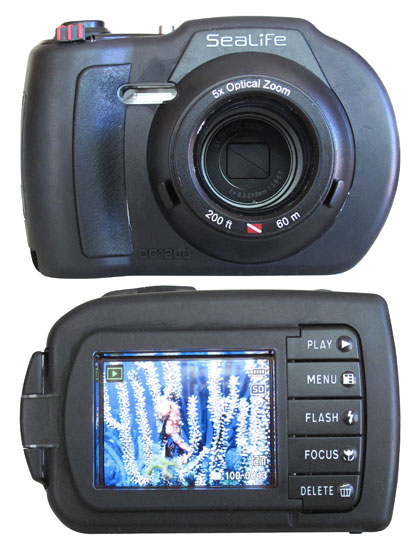
What is the DC1200, and what is new?
The DC1200 is SeaLife's most recent and significantly improved underwater digital camera offering. Sealife usually sells their cameras in various bundles that either contain just the camera and housing, or the camera, housing, strobe(s), lenses and other useful things. We got the DC1200 Elite package (US$899 list) that includes the camera with housing, one SL961 strobe with arm and optical flash link, the SL970 pop-on wide angle lens, a travel case, and some odds and ends. Below you can see the contents of the package (plus a separate rechargeable battery set):
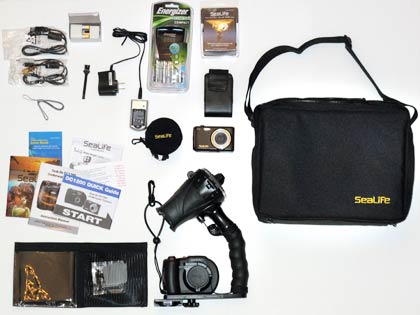
The contents of the SeaLife DC1200 Elite bundle
Those familiar with Sealife cameras know that unlike those clear plastic consumer camera underwater cases with their bright color accents, SeaLife underwater housings are all business. They are made of tough polycarbonate completely encased in grippy black rubber overmolding. All that rubber makes perfect sense underwater where the camera may bump against rocks, get dragged along the bottom, and is just generally exposed to more abuse than above water. And it also provides extra shock protection should you drop the camera while on land (or on a boat). The SeaLife DC1200 housing can handle depths to 200 feet—a lot deeper than the 130 feet depth limit recommended for recreational diving.
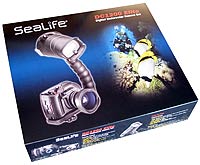 Case construction is simple. It's a hinged clamshell with a fairly small latch that can be a bit of a fingernail buster. The case is easy to hold and ergonomically correct. As in past SeaLife cases, the thick black O-ring sits loose in its groove. That makes this all-important seal convenient to examine, clean and replace, but also easy to pop out, crimp, and get lost. Case construction is simple. It's a hinged clamshell with a fairly small latch that can be a bit of a fingernail buster. The case is easy to hold and ergonomically correct. As in past SeaLife cases, the thick black O-ring sits loose in its groove. That makes this all-important seal convenient to examine, clean and replace, but also easy to pop out, crimp, and get lost.
The flash assembly that comes with the Elite (1 flash) and Maxx (2 flashes) packages is equally handy and no-nonsense. Unlike some strobe and bracket gear that are unwieldy and weigh a ton, the plastic/rubber/foam rubber SeaLife flash assembly is light and doesn't get in the way. The arm is not very long—just about eight inches—but, lacking the usual adjustment knobs and wheels, is simple to bend into whatever position, angle and direction you want.
The one big difference between this latest SeaLife and its predecessors, as well as virtually every other underwater camera, is its controls. NO MORE TINY BUTTONS! Instead, there are five large push controls that SeaLife calls "piano keys." If that sounds like a minor thing, it's not. It makes the camera infintely easier to use underwater. More on that later.
Below you can see the SeaLife DC1200 in action (note the diffuser on the flash; that's a must-have accessory).
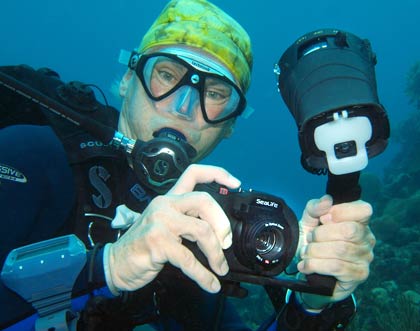
DC1200 specifications and features
Taken out of the underwater housing, the DC1200 camera looks no different from your standard modern 12-megapixel digital point & shooter. That's up by two megapixel from the DC1000 and you now get 3968 x 2976 pixel in maximum resolution. That is more than enough for cropping pictures, zooming in to small details, and making very sizable enlargements. You can also set the camera to various lower resolutions modes and also vary image compression (fine/standard/economy) if card storage space is an issue.
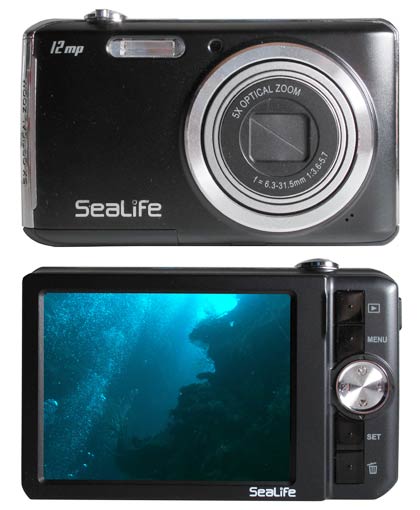
The camera comes with 32MB of onboard memory (why still so little in the era of smartphones with as much as 32GB?) and a SD Card slot that can handle the larger capacity SDHC cards (up to 16GB cards have been tested).
Focal length is 6.3 to 31.5 millimeters, or 34 to 170mm in the old 35mm film camera parlance. The camera has a 5X optical zoom (plus 5X digital magnification, which we never recommend using). We miss the older SeaLife DC800's lens that started at a slightly wide 28mm, which would come in handy underwater.
Movies record at a full 30 frames per second now, at 320 x 240 or 640 x 480 pixel format and the camera records sound with movies, even underwater. We would have liked to see at least 720p HD (1280 x 720) video here, which is increasingly becoming standard in consumer cameras.
Sensitivity, while generally best left in automatic, can be set to 64, 100, 200, 400, 800 or even 1600 ISO. There is a self-timer, and the built-in flash now seems to have six modes: automatic, on, off, slow-sync, strong, and red-eye reduction.
According to the manual, the normal focus range goes from two feet to infinity. A macro range let's you get as close as four inches and remains usable to three feet, and the quick infinity setting gets as close as three feet.
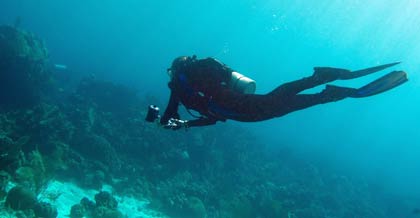 Flying over the reefs of Roatan with a SeaLife. This is actually a fellow diver who had an older DC800 and was quite interested in the new DC1200 rig.
Flying over the reefs of Roatan with a SeaLife. This is actually a fellow diver who had an older DC800 and was quite interested in the new DC1200 rig.
There has been a trend towards bigger screens on cameras, and the DC1200 now sports a larger 3.0-inch display. Resolution is unchanged from the DC1000 at 230k pixel, but the bigger screen size is welcome. You can still adjust brightness, but it's now only either normal or full bright, not in increments.
The DC1200 is a point & shoot camera that you set either in automatic mode or one of well over a dozen scene modes. The scene modes are:
- automatic
- sea
- snorkel
- external flash auto
- external flash manual
- panorama
- landscape
- sunset
- sunrise
- snow
- beach
- sport
- night scene
- splashing water
- flowing water
- AV (aperture priority; available in external flash manual only)
- TV (shutter priority; available in external flash manual only)
Anti-shake is no longer a separate scene mode as in the DC1000; it's now either on or off. That makes sense. And the manual settings mode is now available only in the manual external flash mode where you can choose from AV f/4 or f/6.3 and set TV from 1/500th to 1/60th second. Make sure you try them out as proper depth of field can make a huge difference in underwater photography.
In "Snorkel" and "Sea" modes, you get additional white balance modes for shooting in depths of up to 25 feet (default for snorkel) and one for shooting below 25 feet (default for sea). That's because red only penetrates about ten feet and orange disappears at 25 feet, so a white balance that takes that into consideration really matters. SeaLife has been working with ways to handle this phenomenon over the years. In the DC1200, you set white balance by depth and select from:
- Blue Water<25ft (for snorkeling and shallow diving)
- Blue Water>25ft (for deeper diving in "blue" water)
- Green Water<25ft (for snorkeling and shallow diving in water with higher algae content)
- Green Water>25ft (for deeper diving in "green" water with higher algae content)
You can also set the white balance manually, and we've had very good results with that as well (a white fin came in very handy in calibrating the white balance).
The other underwater modes, "External Flash Auto" and "External Flash Manual" are used with one of SeaLife's impressive external flash accessories, and those are a must-have for serious underwater photographers. Note that SeaLife uses an optical external flash trigger: the light from the internal flash is picked up by an optical cable and triggers the external flash.
The DC1200 also has a number of different capture modes that, interestingly, are not in the "Capture" menu, but in the "Function" menu:
- Single
- Continuous (up to three images)
- AEB (three shots with exposure bracketing)
- SPY (interval shooting from "fastest" to one shot every hour)
- Cont. Flash (like continuous, but with flash)
- Burst (continuous shooting)
- Pre-Shot (two-step process that lets you select a background, then have someone else take the shot)
- Couple Shot (let's you combine two people into one shot)
- Album Shot (puts three shots into an album-like layout)
"Pre-Shot" is for when you want to predetermine a background that you can then quickly go back to, or have someone else take the picture. It works by taking a faint ghost picture that stays on the screen so you can easily match the background again. The ghost background picture is just for help; it does not actually record. A variation of pre-shot is "Coupl.Shot" where you take a picture of a subject on the left side, then use the ghost to line up and add a second person (like the photographer) into the picture. The two are combined.
Overall, the camera is relatively generic hardware tweaked by SeaLife with special firmware, programming and settings for use underwater, and the camera is then packaged with a simple, very functional underwater housing and tried-and-proven external flashes.
Over the years, SeaLife has experimented with making their cameras as easy to configure and use as possible, and their latest easy-setup mode indeed couldn't be simpler: Are you shooting underwater or on land? If underwater, are you using a flash or just the camera? If flash, that's it. If camera, are you snorkeling or diving deeper than 25 feet? If you select "land," that's it, no further questions.
SeaLife external flash system
When it comes to taking pictures underwater, light is everything! There is a world of blazing color down there, but you cannot always see it because colors are different underwater. Colors are really nothing more than different wavelengths reflected by an object. Underwater, waves travel differently, and some wavelengths are filtered out by water sooner than others. Lower energy waves are absorbed first, so red disappears first, then orange, then yellow. Green stays longer and blue the longest, which is why things look bluer the deeper you go. So if you want to capture all those wonderful colors, you need a strong flash.
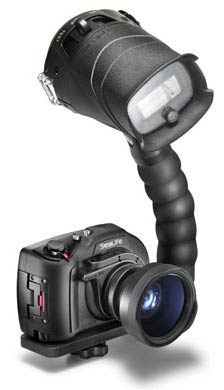 Our Elite package came with a single flash (for best possible illumination of subjects you may want to consider a dual flash setup). The optical flash link snaps onto the underwater housing. It covers the internal flash window so it can pick up the firing of the camera's flash without letting the internal flash illuminate debris that results in "scatter" on images. Our Elite package came with a single flash (for best possible illumination of subjects you may want to consider a dual flash setup). The optical flash link snaps onto the underwater housing. It covers the internal flash window so it can pick up the firing of the camera's flash without letting the internal flash illuminate debris that results in "scatter" on images.
The Digital Pro Flash, which uses four AA batteries, has a pre-flash and an automatic mode switch that can be set to accommodate SeaLife or non-SeaLife cameras. The flash also has an external flash intensity control knob that can be set to automatic or manual control of flash intensity, from darkest to brightest. In our testing, the SL961 Digital Pro Flash was near perfect; we never once had to adjust it or try different settings, and the NiMH rechargeables we used lasted a long time.
While the external flash adds a bit of size and bulk to the camera setup, that's not much of an issue once you are underwater. The flash arm is tightly wrapped in grippy foam and can easily be adjusted.
Allow time to get used to a flash. Positioning the flash properly for a shot can make all the difference. Play with angles and distance. See how pointing the flash this way or that can be the difference between a great shot and one where the extra light simply illuminates all the debris and flotsam in the wwater. Once you get the hang of it, you'll be rewarded with wonderfully rich, colorful pictures that are simply not possible without a flash
Shooting underwater with the DC1200
We tested the DC1200 Elite system during a ten-day product review trip that took us to the Honduran island of Roatan. There, I used the DC1200 on most of my 28 dives that ranged from fairly deep (110+ feet) wall dives, to wreck dives, to just playing in the shallow reefs. The following are notes and opinions we recorded throughout the trip.
Love those "piano keys"! — The first impression of the DC1200 underwater was excellent. The new key arrangement of the hardware controls is a total winner. Being able to simply push a large key for major functions (Playback, Menu, Flash, Focus, Delete) instead of messing with tiny buttons makes operation underwater immeasurably simpler and more pleasant.
Consistently good pictures — The second pleasant surprise is picture quality. The DC1200 did something that is usually impossible underwater: virtually all pictures came out well. You can absolutely not take that for granted. The camera did exceptionally well with colors, focus, and exposure. In fact, the captured pictures always looked much better than what I saw on the screen.
Battery — We were not so pleased with the battery, which is clearly undersized (and actually significantly less powerful than the DC1000 battery was). It lasted me through a dive and a half, and that is not enough. First I thought that the battery was perhaps not fully charged, but the same thing happened the next day: after a dive and a half (about 90 pictures and a few minutes of video), the little battery was dead. So always bring a spare or two.
Flash — The flash worked exceptionally well. It is amazingly light, very easy to use and handle, and also very easy to adjust underwater. The clever diffuser accessory made all the difference in eliminating backscatter. Do note that in External Flash mode (which is what we used 90% of the time), the flash always fires. That's generally a good thing as the diffuser helps illuminating subjects without also illuminating scatter. However, there are times when there is a lot of floating stuff in the water and not much light, and scatter will show up. In those cases, either cover the flash with your hand, point it away, or simply turn it off.
Easy toggling between modes — I also really like the new mode arrangement. With older SeaLife cameras it wasn't clear at all how to move between recording picture, video, and playback. Now, there is a button that toggles between still and video, and a key to go to playback, simple as can be.
Much better shutter and zoom — Love the large shutter button. Also very clever: to move up and down in menus, you use the zoom lever. That works much better than a tiny button diamond.
White balance — In movie mode you have to set white balance manually. In a lengthy move shoot in shallow water, I had inadvertently left white balance i then blue water deep setting, and that resulted in a rather reddish picture at 20-30 feet, so some experimentation is required. On the next dive I set the white balance to blue water and less than 25 feet, and the color looked much more natural, even at 30 feet. Note that the amount of sunlight makes a big difference, too. On a bright sunny day there will be more red, and you can use the shallower than 25 feet much farther down.
Good video, but... — Overall, video is quite good. It is, however, only VGA (640 x 480). No wide format or higher resolutions, and no high definition. HD is becoming quite common even in inexpensive cameras, and so we'd definitely, like to see that in the next SeaLife camera.
LCD viewing angle — The LCD is bright, especially with the extra brightness setting on, but underwater it was hard to see. The problem is contrast more so than brightness; even with brightness set to high, the display was hard to read. The apparent low contrast is primarily because of the small vertical and horizontal viewing angle of the LCD. This means you have to look at the display head-on, which isn't always possible when diving. The LCD definitely does not do this fine camera justice. It's not so much in playback mode where the picture quality is good, but in live view mode where things are way too dim and flat. I often took a shot thinking it may not come out because the display showed next to nothing, and then the picture came out well and much more contrasty.
Another issue is that the display didn't always show the white balance properly. Indoors, automatic white balance made the LCD look very red. Setting it to incandescent made matters worse. Only manual white balance made for a natural looking LCD. Interestingly, the pictures always came out just fine, so this may have been a software issue with the display.
Button glitch — The Sealife 1200 has three flash intensity settings for macro, normal and infinity. However, I was unable to change the flash setting with the Flash "piano-key" on the camera housing. After diving I found that the piano-key button of the housing did not make enough contact with the flash control on the camera. This probably was a pre-production adjustment issue and is likely resolved by now.
Fogging — We also ran into a problem with the housing lens fogging inside. After being underwater for some 35 minutes, all of a sudden the housing lens was all fogged up. I realized I had forgotten to use a "moisture-muncher" dehumidification cartridge. I put one in, but the fogging still happened with it, again about 35 minutes into the dive. The next day I followed the manual precisely, putting the camera into its housing in our room and never opening it outside or on the boat. Yet, 35 minutes into the dive it happened again. Interestingly, ten minutes later, still underwater, it had cleared up and the camera was ready to shoot again. This happened several more times. We never had that problem with the DC800 or DC1000, so it may have been an unusual combination of humidity and temperature, or something else.
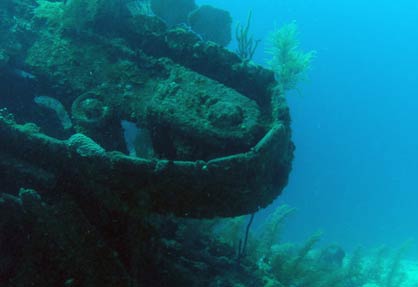 That's what a bulldozer looks like after a few years under water.
That's what a bulldozer looks like after a few years under water.
I found myself quickly feeling great confidence in this camera because it so reliably shot good pictures. You absolutely can't take that for granted underwater where there is hardly ever enough light, and everything constantly moves. The DC1200's auto focus seems exceptionally smart and sure-footed, and it's quick. Also, the camera seems smart enough to not simply compensate with unacceptably slow shutter speeds that would make pictures blurry.
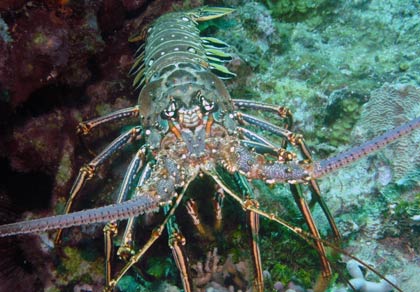 And a Caribbean spiny lobster. I much prefer them in their holes than on my plate.
And a Caribbean spiny lobster. I much prefer them in their holes than on my plate.
As far as focus modes go, we had experienced some frustrations with the DC1200's predecessor camera, the DC1000, due to that camera's overlapping focus settings. You had to pay close attention to the focus setting or you ended up with a lot of blurry pictures. The DC1200 also offers three focus settings. Per the manual, they are:
- Macro — good from as close as four inches to about three feet (without zoom)
- Auto Focus — good from two feet to infinity (without zoom)
- Infinity — works from about three feet to infinity and is fast because the focus is locked and so the auto focus won't spend time hunting.
You can see the problem: Infinity is quick, but you can't get closer than about three feet. Normal auto focus mode lets you get as close as two feet and all the way to infinity, but it's slower and you can't go real close. Macro let's you get real close, but things get blurry past three feet or so.
The DC1000 was pretty unforgiving in that regard, and so we we did 15 test pictures with the DC1200—five each in the three focus modes—in a controlled underwater environment, taking the same shot from within four inches, to a foot, two feet, three feet, and four feet, which is about the range when you're rummaging around a reef or some other interesting macrolife. The table below shows what modes, according to our test pictures, work best at what distance with the DC1200:
|
Focus/Distance
|
4 inches
|
1 foot
|
2 feet
|
3 feet
|
4 feet
|
|
MACRO
|
Sharp
|
Sharp
|
Sharp
|
Sharp
|
Marginal
|
|
NORMAL
|
Blurry
|
Sharp
|
Sharp
|
Sharp
|
Sharp
|
|
INFINITY
|
Blurry
|
Blurry
|
Marginal
|
Sharp
|
Sharp
|
In practical use, we found the DC1200 actually to be quite forgiving, with the ranges being wider than the manual suggests. Normal shooting mode was good for as close as a foot, but when going for longer distance shots, it really paid off to quickly switch to the faster infinity mode. It's a matter of getting a feel for the camera as you can't really tell whether a picture is truly sharp on a 3-inch display.

The SeaLife DC1200 Elite
What you get with SeaLife's DC1200 Elite package is a small and fairly simple 12-megapixel camera that's been optimized for underwater shooting, a superb underwater case, a tried-and-true underwater flash, a 24mm wide angle pop-on lens, plus some assorted cables/chargers/manuals in a nice soft case.
SeaLife's new "piano-key" controls make it MUCH easier to quickly change settings. They can be operated even with gloves on, and having quick and simple access to large controls will result in better pictures. We also liked the large shutter and zoom.
The DC1200 camera itself excelled. It was forgiving, quick, and we managed to get a lot more good pictures than with almost any other underwater camera in this price range.
The 3-inch LCD is large, but its very small viewing angle makes it difficult to see and use underwater.
The flash was a pleasure to use. It seemed extremely well matched with the camera and we didn't have to experiment with settings at all.
Overall, the DC1200 is by far the best SeaLife camera we have ever reviewed.
We like:
- Handy 12-megapixel camera with excellent underwater case (200 feet depth)
- Without housing, it's a small and handy digital camera for use anywhere
- Tough, rugged housing simple to use and operate
- Excellent "Easy Set-up" wizard
- Novel "piano key" control arrangement on housing works great!
- Large shutter and zoom
- Very good picture quality with most pictures coming out well
- Handy external flash with easy-to-manipulate arm
- Large LCD good for reviewing pictures
- Elite package comes with everything you need
Keep in mind:
- Undersized battery only lasted a dive and a half
- LCD has low contrast and narrow viewing angle
- Getting the proper white balance for a depth and lighting condition takes practice
- Housing latch a fingernail buster
- We had some inexplicable housing lens fogging issues
- Flash "piano-key" didn't make contact (probably a pre-production issue)
- Black O-ring in black housing easy to lose; we'd prefer a color one that'd not come out as easy.
|










